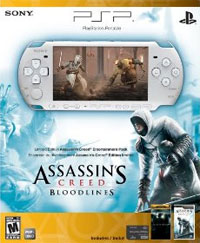
It’s been something I’ve waffled over doing ever since I first joined up with GAMBIT. Should I? Shouldn’t I? It’s a lot of money, the ROI is somewhat questionable, but… But… Finally, yesterday the stars aligned, the proper slot machine tumblers of fate finally clunked into place, I was in the right place and the right time, and I found myself slapping my credit card down to buy a shiny new Sony PlayStation Portable, AKA the PSP.
What were the factors? I’m so glad you asked.
Research. I’ve been considering the PSP as a great platform for transmedia extensions for a while now, but the release of Assassin’s Creed II: Bloodlines as a PSP-only narrative bridge between the Assassin’s Creed and Assassin’s Creed II console games clinched the deal. Throw in the PSP-exclusive Final Fantasy VII: Crisis Core and the upcoming Kingdom Hearts: Birth by Sleep and this reason hit #1 with a bullet.
Timing. Call it a near-miss of synchronicity: not only do I turn 32 on Sunday, but yesterday was the PlayStation’s 15th birthday. This is making me feel both old and nostalgic; the fact that I can buy Final Fantasy VII at all for the PSP is awesome, but I vividly remember being a freshman in college and having my socks knocked off by my friend Kurt’s shiny new copy of Final Fantasy VII. What can I say? I wanted to give myself a birthday present, and so I gave Sony a birthday present of my money.
Curiosity. Discovering the existence of a cradle for the PSP made me imagine using the PSP as an always-on Internet appliance. I’ve been looking at things like the tiny little Mimo USB-driven minidisplays and the new Chumby One as small Internet-enabled devices, functioning as simple kiosks for things like Flickr and Twitter.
So now I have my very own PSP-3000, courtesy of the PSP 3000 Limited Edition Assassin’s Creed: Bloodlines Entertainment Pack. It’s a strange color, described by Sony as ‘pearl white’. This is something of a misnomer; I was expecting something kind of irridescent, like, well, a pearl. It isn’t. Instead, the thing glitters. It’s not that bad, especially when it’s in a relatively low-light situation, but when the sun hits it just right, the sucker glitters like goddamned Edward. (Yes, I went there.) Again, it’s not that bad, but I’m admittedly considering buying some kind of leather sheath for the device to man it up a little.
I haven’t gotten to play the game very much yet, but so far my expectations for this device as a pocket computer have been coming down on the wobbly side. It’s not entirely Sony’s fault; I’ve been a heavy iPhone user since its initial release, so many of my expectations for what a portable device can and should be have been notably skewed – but when I started playing with the PSP, I realized that I had completely taken for granted that I’d be able to obtain some kind of dedicated Twitter app for this thing. Not only is that only apparently not the case (at least without hacking the device and installing some alternate form of OS, perhaps) but the experience of typing on this beast has been so utterly execrable that the very thought of attempting to write on this thing for even 140 characters at a time makes my ass twitch. Even attempting to pull up the Twitter site on a PSP is a groanworthy undertaking – not only is the browser astonishingly slow, but the wi-fi connection must be reestablished every time you launch it. This makes sense at some level – switching the wi-fi on and off as needed is a logical way to extend battery life – but asking me which of my established networks it wants me to to connect to every time is ridiculous, especially when the two choices are the network here on campus and the network at home. One simple bit of automated checking would have removed this annoyance: if one network is available and the other isn’t, don’t ask.
Another aspect of this thing which is distinctly odd is the sensation of having a spinning piece of physical media in the back of the device, and almost no on-deck storage. Again, this is almost certainly the result of being an early adopter of the iPhone and a very, very late adopter of the PSP, but I was somewhat amazed that I couldn’t install my copy of Bloodlines to some kind of internal drive and then retire the Universal Media Disc (UMD). True, I can’t do that with my Nintendo DS, either, but for some reason I thought of the PSP as a more forward-thinking device. Ha.
In fact, for a brief little while after first popping the UMD into the device I seriously considered taking the thing back and getting a PSP Go instead – and this is despite the litany, or even cacophony, of utterly disastrous reviews that have been lambasting the Go. As Ars Technica’s Ben Kuchera so devastatingly advised Sony, “when your older, cheaper hardware is better and more able than your new offering, you need to fire some designers”. Ouch.
So why was I even considering swapping the PSP-3000 for a PSP Go? First, I’m a design junkie, and the Go’s slider-style industrial design is very sexy. Second, I’m also a digital downloads enthusiast – I can’t remember the last time I bought a CD, and my physical Netflix discs have been sitting on the shelf gathering dust ever since Netflix Streaming arrived – and the PSP’s digital-download only model is, in the abstract, incredibly attractive to me. Plus, the PSP Go is smaller, and as I noted in an earlier post, recent health issues have made me start to seriously reconsider how much junk I’m willing to carry around on a daily basis. If I’m going to add another device to my satchel, it’d better weigh as little as possible.
Still, the naysayers on the Go have me convinced. The fact that Sony’s digital download versions are more expensive than the physical versions is a deal-killer, amplified by the fact that I can’t buy heavily-discounted used UMDs and rip them into playable digital versions the way I might buy some used CDs and rip them into perfectly servicable MP3s. Sony also backed off on a planned trade-in program swapping physical media for digital versions, so UMDs and the PSP Go will apparently never get along – and since Crisis Core isn’t available on for digital downloading yet, then 25% of the games driving me to buy a PSP at all just went away. (That number jumps up to a full one third given that Birth by Sleep isn’t out yet.) I’m clearly a Square-Enix fan, as 75% of my PSP game wishlist are Squeenix games, but God knows I’m not the only one. Sony’s managed to get Squeenix to put FFVII on their digital download service and (I think) the Final Fantasy-themed brawler Dissidia (itself a chimera of somewhat dubious genetics), but until Squeenix commits that all its future games will be available for downloading, then owning a PSP Go makes no sense for me.
As it is, this strange little device represents a fascinating new toy to tinker with over the holidays. I’m looking forward to taking it on our honeymoon so I can whack some Templars while en route to Florida, and I’m holding out hope that when I really start tinkering with it I can hack it to do some of the other things I thought it might be able to do out of the box – but I can’t shake the feeling that in this post-iPhone environment, Sony is really missing out by not making those very functions stock. I’d pay a couple extra bucks per function if Sony enabled app downloads on their PlayStation Network, letting me set up my PSP as a kind of Chumby lite. I’d also jump at the chance to buy the PS2’s Kingdom Hearts and Kingdom Hearts II on it the same way that I can get Final Fantasy VII, but apparently they’re not available yet – or if they will ever be made available at all.
This drives home one of the negative affordances inherent in games as opposed to books, music or (now) even movies: books, music and movies all convert fairly well to portable versions which can be stored on one’s laptop or phone, but console video games are almost completely locked down into one’s living room. The PSP offers a function called ‘remote play’ which was, I believe, designed to address that somewhat, and the screen-to-screen interaction between Assassin’s Creed II on the PS3 and Assassin’s Creed: Bloodlines on the PSP is what drove me to switch to the PlayStation versions of the franchise from the Xbox 360 version I have of Assassin’s Creed – but there is still such a very long, long way to go before I can be playing Uncharted 2 on my living room couch, pause the game, run out and jump on a bus to work, then pop open my PSP and continue the game from where I left off. Even taking greatly reduced graphics and other concessions to the form as givens, I feel like this is where we’re heading. The fact that we’re not there yet is slightly annoying – especially as games are attempting to become bigger and bigger components of the media diet of increasingly over-busy adults.
At the end of the day, I’m still fairly happy I bought my PSP, and I’m still looking forward to playing with it. That said, I’m looking forward even more to playing with what comes next, in the hopes that it will do what I hoped this device would do – and, with a little luck, the PSP2 or whatever it’s called will arrive before it has an entirely new set of unrealistic expectations set for it by the rest of the market.


